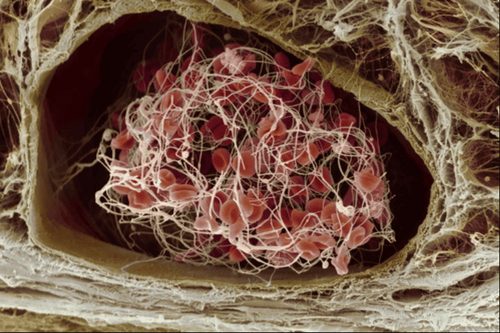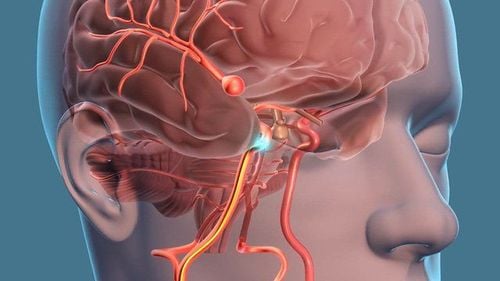This is an automatically translated article.
A subdural hematoma is when a blood clot forms under the dura. Too large a subdural hematoma will increase intracranial pressure, cause compression, cause severe brain damage and potentially lead to death.1. Overview of subdural hematoma
1.1. Learn about the meninges and the subdural space Meninges are understood as the lining to protect the brain, enclosing the entire brain in the skull and surrounding the entire spinal cord in the spinal canal.
The meninges consist of 3 layers:
The innermost layer closest to the brain and spinal cord is called the pleura. The middle layer is the arachnoid membrane The outermost layer close to the skull/spinal cord is the dura mater. Between the meninges, there will be 3 middle compartments including:
Epidural space: this is the space between the skull and the dura mater, in the cranium this is considered a virtual space, the dural space only appears when there is pathology. Subdural space: is the space between the arachnoid and the dura. Subarachnoid space: space between the soft membrane and the arachnoid membrane. 1.2. Definition of subdural hematoma
A subdural hematoma is a hematoma that forms in the subdural space. A subdural hematoma occurs when there is a head injury. Head trauma injures and bleeds from one or more other blood vessels near or in the subdural space. Blood flowing from these vessels collects in the subdural space. Head trauma also causes damage to the brain parenchyma.
1.3. Classification of subdural hematomas Subdural hematomas include 3 types:
Acute subdural hematoma: is when a hematoma is rapidly formed in the subdural space right after a head injury, symptoms Symptoms appear immediately or within a few hours at the latest. Subacute subdural hematoma: when symptoms appear 3-7 days after head trauma. Chronic subdural hematoma: A hematoma forms slowly, with symptoms appearing 2 to 3 weeks after a head injury.

Máu tụ dưới màng cứng được phân ra làm 3 loại
2. Cause
It is mainly caused by a severe head injury that causes the vein in the subdural space to tear. The tear causes blood to flow into the cavity, forming a blood clot that compresses the brain tissue (usually acutely).
Subdural hematoma in the elderly is easy to occur even if it is only a very small head injury, because in the elderly, veins are often dilated, so it is very vulnerable.
Subdural hematomas are sometimes also caused by spontaneous bleeding that is not caused by head trauma. This usually occurs in people with bleeding disorders.
In addition, a subdural hematoma is also caused by another rare cause, which is blood flowing from a bulge of a blood vessel (cerebral aneurysm). The wall of the brain aneurysm is quite weak, so it is easy to burst and cause bleeding.

Người bị rối loạn đông máu dễ gặp hiện tượng máu tụ dưới màng cứng
3. Symptoms
Symptoms of a subdural hematoma will depend on the severity of the head injury and the size and location of the hematoma in the cavity. Symptoms may appear immediately or take several weeks after the injury.
3.1. Symptoms of Acute Subdural Hematoma Appears immediately after a head injury, after a few minutes or hours. It is possible to pass out immediately upon injury (but not always).
Some people remain awake after a head injury but are left in a coma a few hours later when a hematoma in the brain cavity forms. Some typical symptoms include:
Total loss of consciousness or gradual change in level of alertness. Nausea or vomiting Mild to severe headache Dizziness, loss of orientation Inability to pronounce words Convulsions Unusual breathing One limb weakness and difficulty walking Amnesia. 3.2. Symptoms of subacute and chronic subdural hematoma Symptoms of subacute subdural hematoma are similar to those of acute but only clear up after 3-7 days.
With chronic, symptoms will appear 2 - 3 weeks after the injury, in some cases it may take several months to appear. Chronic subdural hematomas may be caused by minor trauma or by forgetting that they have ever had a head injury. Specifically, hematoma in older people taking anticoagulants, or in alcoholics.
Chronic subdural hematoma is difficult to detect and easy to miss. Symptoms appear with an increasing tendency and include:
Loss of appetite Persistent nausea or vomiting Headaches ranging from mild to severe and persistent Weakness of limbs on one side of the body Difficulty speaking Difficulty Vision vision disorder Drowsiness Confusion, forgetfulness Sometimes even seizures.
4. Is subdural hematoma dangerous?
Subdural hematoma is very dangerous, not only endangering the patient's life but also leaving a lot of permanent sequelae.
Whether a subdural hematoma is dangerous will also depend on the extent of the injury as well as the size and location of the hematoma. Many cases of small blood clots can make a full recovery quickly.
With cases of acute subdural hematoma, if there is no brain tissue damage, about 4 out of 5 people will survive. If there is accompanying brain tissue damage, the chances of survival are lower. Some patients die because of a large hematoma in the brain.
Complications such as infection or meningitis can occur during surgery. Submeningeal hematomas also cause permanent damage such as weakness, speech difficulties, confusion, poor memory or memory loss.

Tụ máu dưới màng não gây biến chứng vĩnh viễn như suy giảm trí nhớ, lú lẫn
Vinmec International General Hospital is one of the leading hospitals in Vietnam, always guaranteed for the professional quality of the medical team. The most modern equipment and technology system. Medical services are always comprehensive and professional.
Please dial HOTLINE for more information or register for an appointment HERE. Download MyVinmec app to make appointments faster and to manage your bookings easily.













